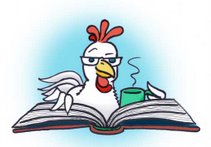I've got a group of really smart, spirited 5th graders. Today several of them sauntered into the library at lunch recess with their usual demand for "good books." I skipped my usual answer to the kids I think can take it ("Sorry, we only have BAD books here. BAD, BORING books.") and they turned their attention to the big sign near the checkout desk, the one that says "WARNING: This library may contain unusual, hilarious, fascinating, sinister, and even frightening things. Read at your own risk."
I asked, "Do you want to see the book that won this year's Newbery award, that there's a big controversy about?"
"Oh!" a couple of them said. "I heard about that! It was in the New York Times!" (Like I said-- smart kids.) They gathered around our brand-new, still-uncataloged copy of The Higher Power of Lucky and scrutinized the fateful first page.
What followed was every librarian's dream (well, every librarian I know; maybe not the ones quoted in the Times article): a whirlwind discussion of the First Amendment, the mechanics of challenging or banning books in this country as opposed to places where the government restricts freedom of the press (one kid cited Nazi Germany as an example), their opinion of the ridiculousness of sheltering kids from knowledge of names of body parts that half the population possesses (with some rowdy joking about people who don't know their own anatomy), the concept of twelve-step groups and addiction, the need for a waiting list for this particular book since at least one kid desperately wanted to read it and it's not cataloged yet, and how cataloging a book for the library works.
We ended up with a quick tour of the books in our library that have been banned or challenged, like the "Scary Stories" series, Robie Harris's It's So Amazing, and To Kill a Mockingbird ("But isn't that taught in a lot of schools?" "Yep. And it's also been challenged in a lot of schools.") , finishing with a visit to the ALA Most Banned Books list, where the kids were shocked and scornful to see Harry Potter ("Harry Potter?!?") right up there at Number 7.
I herded them out the door for lunch amid a babble of demands (like I said--spirited kids): "Can we have a list of those books?" "Can I check that book out?" "You need to teach a class on this. THIS WEEK!"
Now, I work at a small private school and might have more than ordinary freedom to wing it, and this is an unusually sophisticated bunch of kids; I probably wouldn't have been quite so forthcoming with a group of 3rd graders. And who knows; I might get some feedback, positive or negative, from a parent tomorrow. But I'd hate to think of working in a library where I couldn't be open to that kind of spontaneous conversation. And as a parent, I'd hate for my daughter to miss out on a learning opportunity like that because her teacher or librarian was too scared of a parent's potential complaint.
And boy, do I have a great hook now for the Newbery unit when we get to that in 5th grade later this year.
Subscribe to:
Post Comments (Atom)

2 comments:
You are a library Goddess.
And you remind me of the librarian in the children's section of the main branch of the Brooklyn Public Library when I was a kid. Ask her where something was and she introduced you to the mechanics of the card file. Ask her for a recommendation and she introduced you to the mechanics of whole new worlds.
This is just fabulous -- both your approach and the kids' responses.
Please post more about it when you do the Newbery unit!
I'm still back-and-forth with myself on whether to read it to my (fairly mature) first-grader, but I think I'll hold off a year or two. There's plenty else to read till then, and he'll probably get more out of it then.
Post a Comment